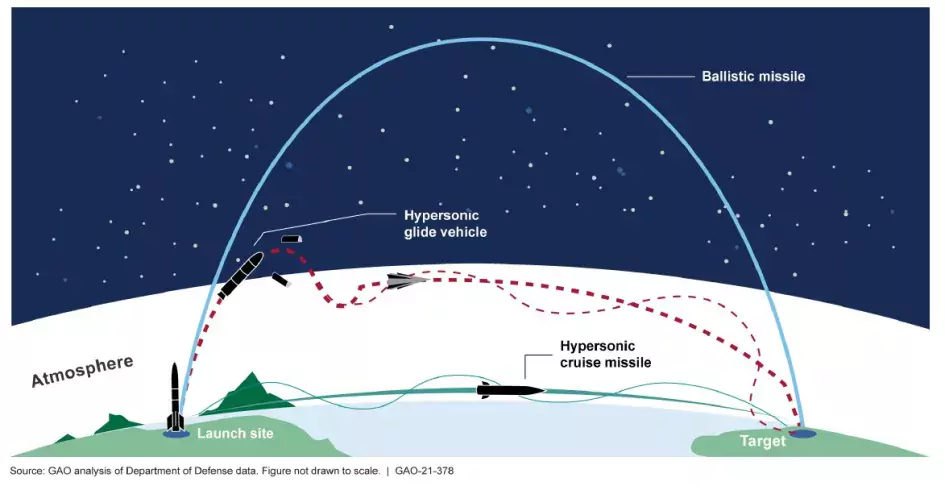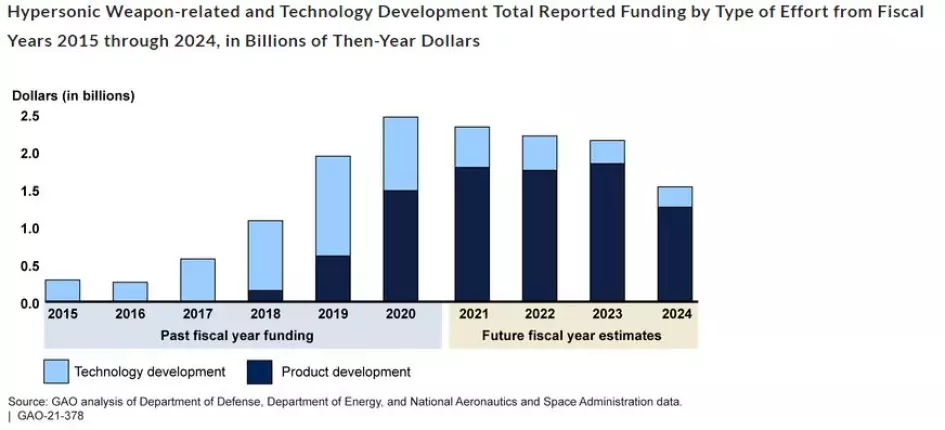Faster Than The Speed of Sound — U.S. Efforts to Develop Hypersonic Weapons
The Department of Defense (DOD) is working to develop hypersonic weapons—which are capable of moving at least five times the speed of sound, have unpredictable flight paths, and are expected to be very difficult to defend against.
Today’s WatchBlog post looks at our new report on these weapons, and the opportunities and challenges they present.
What are hypersonic weapons?
Hypersonic weapons are capable of reaching at least Mach 5, or approximately 3,800 mph. While traditional long-range missiles (e.g., ballistic missiles) can reach similar speeds, hypersonic weapons can also fly at different altitudes and trajectories. Hypersonic weapons are expected to be very difficult to defend against because they can fly at lower altitudes while being highly maneuverable and potentially change targets mid-flight.
The swiftness of hypersonic weapons might also allow them to hit adversary targets, like mobile weapons systems, that are vulnerable for only short periods of time.
Comparison of ballistic and hypersonic flight trajectories
Image

Developing hypersonic weapons
In our new report, we identified 70 efforts to develop hypersonic weapons and related technologies. These efforts are estimated to cost almost $15 billion from fiscal years 2015 through 2024. NASA and the Department of Energy have agreements with DOD about their roles in supporting the development of hypersonic technology. However, we found that DOD has not documented the roles, responsibilities, and authorities of its own organizations that are working on these projects.
Image

Challenges ahead
Hypersonic weapon systems are technically complex and subjected to extreme conditions over the course of their flight. As a result, they face challenges that other weapons might not, and DOD has taken several steps to mitigate some of the challenges to developing them. For example, stronger and more efficient heat tolerant materials need to be developed to protect the interior electronics of these weapons.
DOD also faces challenges relating to the industrial base (meaning contractors used to develop supplies and other technologies) and human capital workforce investments, which are necessary for large-scale production of hypersonic weapons.
Hypersonic weapons programs are also challenged because they rely on a number of immature technologies that need further development in order to be part of an operational system. And another key challenge is scheduling the testing. Wind tunnels are an essential part of testing hypersonic technology. However, as U.S. interest in hypersonic technology has increased in recent years, so has the demand for time in wind tunnels.
Our report looked at the challenges in coordination and development of hypersonic weapons. We recommended defining and documenting the roles, responsibilities, and authorities of the leadership positions and organizations in DOD who are responsible for the development and acquisition of hypersonic weapons.
To learn more about hypersonic technology development efforts, check out our new report. You can also learn more about how hypersonic weapons work by reading our Science & Tech Spotlight.
- Comments on GAO’s WatchBlog? Contact blog@gao.gov.
GAO Contacts
Related Products

GAO's mission is to provide Congress with fact-based, nonpartisan information that can help improve federal government performance and ensure accountability for the benefit of the American people. GAO launched its WatchBlog in January, 2014, as part of its continuing effort to reach its audiences—Congress and the American people—where they are currently looking for information.
The blog format allows GAO to provide a little more context about its work than it can offer on its other social media platforms. Posts will tie GAO work to current events and the news; show how GAO’s work is affecting agencies or legislation; highlight reports, testimonies, and issue areas where GAO does work; and provide information about GAO itself, among other things.
Please send any feedback on GAO's WatchBlog to blog@gao.gov.




